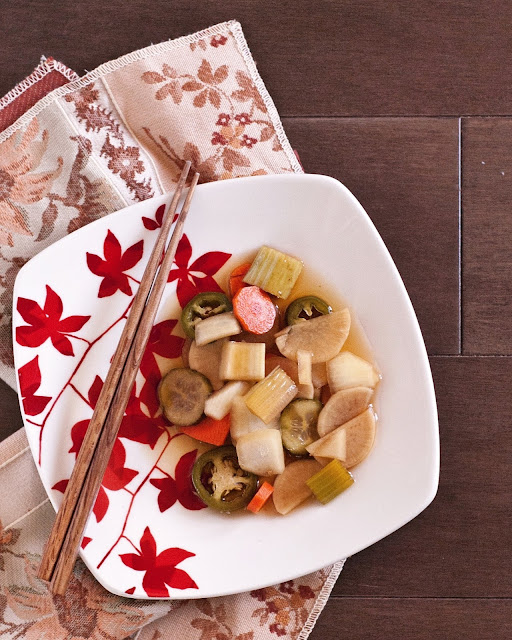LA Jangajji - Korean Pickles
Most cultures have seen their food "Americanized" after arriving here. Usually this means reducing the complexity of the flavors, sweetening them up, cutting out some of the less familiar ingredients, and, most likely, frying something. This food is a far cry from the "authentic" version found in the cultures' home countries and often loses essential elements of the cuisines' core character.
However, when large immigrant communities develop abroad, something different can happen. Groups of people with similar backgrounds who understand the origins and nuances of their culture's cuisine start to develop twists on classic dishes that, while not a bastardization of their original forms, nevertheless grow in a new direction. Such is true of the Taiwanese community here in L.A., where dishes like the beef pancake roll enjoy a more prominent spot on the menu than they do back in their home countries.
One of the largest cultural neighborhoods in the city is Koreatown, and naturally, the same thing happens with the Korean food served here. Having never been to Korea, it's actually this take on Korean cuisine that I know best. One item that's nearly ubiquitous here is Jangajji, which is a sweet and salty pickle that's often served along with its brine as a dipping option at Korean BBQs. Jangajji apparently also exists in Korea, but in LA's Korean community, it's taken on a new form, with a wider array of vegetables and a sweeter, tangier brine.
I followed Maangchi's recipe pretty closely on this one (if you haven't seen her blog, I highly recommend it as a way to learn about pretty much any Korean dish), but I made a couple subs with the peppers and added carrots. This recipe makes a rather large batch, but it'll keep for several weeks in the fridge.
LA Jangajji
1 Korean or daikon radish, cut into strips or half-moons
1 large carrot, cut into small strips
1 yellow onion, diced
4 stalks celery, split in half and sliced into 3/4 in pieces
3 persian cucumbers, sliced
3 jalapeno peppers, sliced
1 cup Korean soy sauce
1 cup white vinegar
1/2 cup sugar
2 cups water
Place vegetables in jar or tupperware container and mix together. Bring soy sauce, vinegar, sugar, and water to a boil in a saucepan and boil until sugar is dissolved. While still hot, pour over vegetables. Let rest until the mixture cools, then refrigerate. Pickles will taste best after a week and can be stored for several weeks.
However, when large immigrant communities develop abroad, something different can happen. Groups of people with similar backgrounds who understand the origins and nuances of their culture's cuisine start to develop twists on classic dishes that, while not a bastardization of their original forms, nevertheless grow in a new direction. Such is true of the Taiwanese community here in L.A., where dishes like the beef pancake roll enjoy a more prominent spot on the menu than they do back in their home countries.
One of the largest cultural neighborhoods in the city is Koreatown, and naturally, the same thing happens with the Korean food served here. Having never been to Korea, it's actually this take on Korean cuisine that I know best. One item that's nearly ubiquitous here is Jangajji, which is a sweet and salty pickle that's often served along with its brine as a dipping option at Korean BBQs. Jangajji apparently also exists in Korea, but in LA's Korean community, it's taken on a new form, with a wider array of vegetables and a sweeter, tangier brine.
I followed Maangchi's recipe pretty closely on this one (if you haven't seen her blog, I highly recommend it as a way to learn about pretty much any Korean dish), but I made a couple subs with the peppers and added carrots. This recipe makes a rather large batch, but it'll keep for several weeks in the fridge.
LA Jangajji
1 Korean or daikon radish, cut into strips or half-moons
1 large carrot, cut into small strips
1 yellow onion, diced
4 stalks celery, split in half and sliced into 3/4 in pieces
3 persian cucumbers, sliced
3 jalapeno peppers, sliced
1 cup Korean soy sauce
1 cup white vinegar
1/2 cup sugar
2 cups water
Place vegetables in jar or tupperware container and mix together. Bring soy sauce, vinegar, sugar, and water to a boil in a saucepan and boil until sugar is dissolved. While still hot, pour over vegetables. Let rest until the mixture cools, then refrigerate. Pickles will taste best after a week and can be stored for several weeks.



Comments
Post a Comment